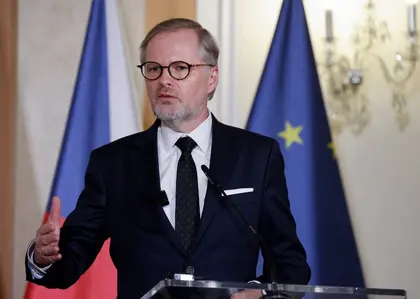In the early morning of Sept. 9, 1999, a massive explosion tore through an apartment building at 19 Guryanova Street, a working-class area of Moscow. The central section of the building was obliterated, and fierce fires burned under the rubble. “It’s like hell underneath,” one rescuer said. “Even if they survived the blast, they would have been burned alive.”
In the end, 100 people were killed and 690 injured.
JOIN US ON TELEGRAM
Follow our coverage of the war on the @Kyivpost_official.
The bombing was one of four in just 13 days in Moscow, Buinaksk and Volgodonsk. In total, they killed 300 people and injured close to 1,000. They helped to elevate Vladimir Putin to power and shaped the nature of his regime. Yet all evidence points to the bombings being carried out by the Federal Security Service (FSB) to put Putin in power.
Twenty-five years later, the story of the apartment bombings offers indispensable guidance to the US on the stakes involved in the war in Ukraine. A regime that came to power through terrorist acts against its own people will not hesitate to engage in mass killings, as it did in Bucha, nor will it treat the borders of NATO as more sacrosanct than the borders of Georgia, Syria, or Ukraine.
The bombings terrorized Russia. People across the country feared being blown up in their beds. Russian President Boris Yeltsin ordered the mayor of Moscow to have all 30,000 residential buildings in the capital searched for explosives. Residents everywhere mounted round the clock patrols.

FSB Officer Shot Dead in Moscow Ministry of Defense Building
In the eyes of the regime, the situation in Russia in the fall of 1999 was extreme. Yeltsin was widely hated. Putin, newly appointed as prime minister, had a popularity rating of two per cent. Yeltsin’s advisers believed that there was no “normal” way for Putin or anyone supported by Yeltsin to win the upcoming presidential elections.
After the bombings, however, the situation dramatically changed. Putin was suddenly on television constantly vowing “to destroy the terrorists in their outhouses.” Russia launched a long-prepared invasion of Chechnya that met with initial success. Putin’s popularity soared. In March 2000, he was elected Russia’s president.
As the days passed, however, it became increasingly clear that the authorities had carried out the bombings themselves. The bomb sites were bulldozed, removing rubble and human remains, destroying the crime scene. Hexogen, the explosive used in the bombings, was produced in only one factory which was tightly guarded by the FSB.
Gennady Seleznev, the speaker of the State Duma and a close Putin associate, announced in the Duma on Sept. 13 that a building had just been blown up in Volgodonsk. In fact, the building that was blown up was on Kashirskoye Highway in Moscow. The building in Volgodonsk was blown up three days later. There is no explanation other than official involvement for the fact that Seleznev knew of the Volgodonsk explosion three days in advance.
On Sept. 23, two people who placed a bomb in the basement of a 12-story building in Ryazan, a city southeast of Moscow, were arrested as the result of a dragnet and proved to be not Chechen terrorists but agents of the FSB. The bomb, which was discovered and deactivated before it could explode, was made of hexogen, the same substance used in the four successful bombings.
Silence and self-censorship
Putin has not been convicted of terrorism in a Russian court and won’t be as long as he is in power. But the evidence shows conclusively that the 1999 bombings were carried out by the Russian authorities, and this justifies treating Russia as a terrorist state.
The US never expressed doubts about the apartment bombings or raised questions about the arrest of FSB agents in Ryazan. On Feb. 8, 2000, when Secretary of State Madeleine Albright was asked by Senator Jesse Helms (R-N.C.) in the Senate Foreign Relations Committee about the bombings, she refused to respond.
The State Department at the time was committed to the idea that supporting Yeltsin was equivalent to supporting Russian democracy. The policy of self-censorship in the case of the bombings, however, was subsequently applied to every terrorist act and assassination in which there was evidence that the real author was the regime.
As the US tries to react to Russia’s aggression against Ukraine, a fundamental requirement is to restore the historical record, beginning with the evidence of state terrorism in the case of the 1999 apartment bombings. There is a section of US opinion which defends the Russian leaders as defenders of Christian values. The story of the bombings can discredit this misconception.
The readiness of the West to raise the question of how Putin came to power can also have an effect inside Russia. Despite catastrophic losses, reaching 1,000 injured or killed a day, Russia is still sending wave after wave of troops at Ukrainian defenses. The history of the bombings can be a reminder to Russians of the regime’s true attitude toward their lives.
The Russia-Ukraine war was preventable. The facts about how Putin came to power can be of vital importance to the US in preventing it from being prolonged.
David Satter is the author of “The Less You Know, the Better You Sleep: Russia’s Road to Terror and Dictatorship under Yeltsin and Putin.” He is the academic advisor to The Remembrance Society, which commemorates the victims of totalitarianism.
The views expressed are the author’s and not necessarily of Kyiv Post.
You can also highlight the text and press Ctrl + Enter








